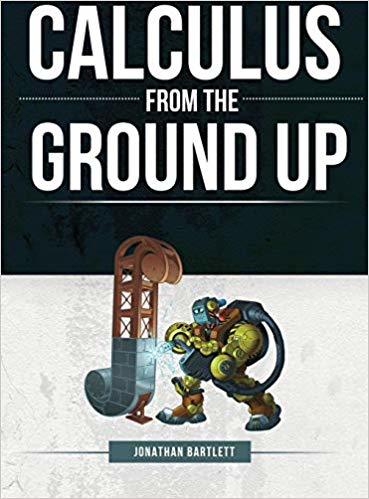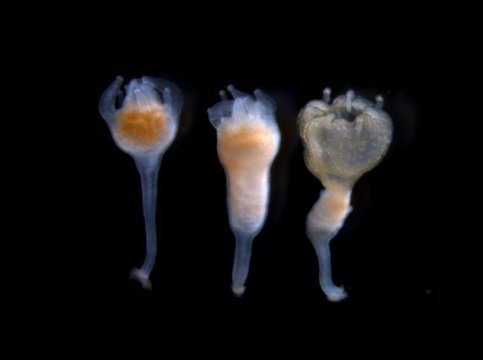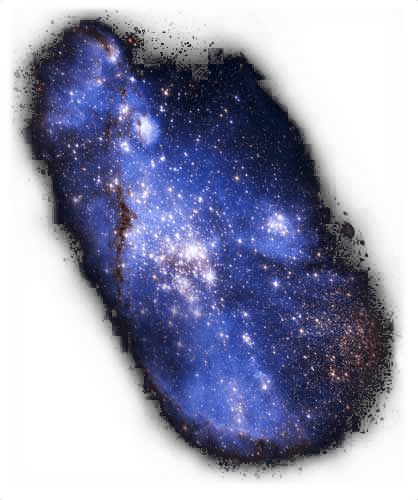Michael J. Behe's Blog, page 494
April 18, 2019
Researcher: Finding helium hydride today confirms its presence from within 100,000 years of the Big Bang
 Big Bang/NASA
Big Bang/NASAHelium hydride had been theorized to emerge within 100,000 years of the Big Bang but had not been detected outside the lab:
The helium hydride ions seen in NGC 7027 were created in the planetary nebula, rather than being leftover from the early universe. But their existence confirms that helium hydride ions can exist outside the lab, which means that theoretical simulations of the primordial cosmos aren’t in serious need of revision.
Adam Perry, who studied helium hydride while at the University of Illinois Urbana-Champaign, likens the new find to unearthing a fossil that fills a missing link in animal evolution. “Everybody knew [helium hydride] had to be out there,” says Perry, who wasn’t involved in the study. But “where before there wasn’t any hard evidence, now there is.… People who do astrochemistry are going to be very excited about this.” Maria Temming, “The first type of molecule to form in the universe has been seen in space” at Science News
Compared to evidence-free claims about the multiverse, news about the filling in of the missing pieces of Big Bang cosmology attracts little attention. Could that be because, however well-attested, the Big Bang is unpopular among cosmologists? (Due, we are told, to its apparent theistic implications.)
See also: Researchers: Universe’s proposed first chemical detected for the first time Researcher: “‘The lack of evidence of HeH+ caused some doubts whether we do understand the formation and destruction of this special molecule as well as we thought,’ Güsten tells Chemistry World. ‘This concern is gone now.’”
Hugh Ross: How recent measurements support the Big Bang theory Maybe the cosmologists who don’t like the theistic implications of the Big Bang can overthrow the current universe and appoint another one?
and
The Big Bang: Put simply,the facts are wrong.
Copyright © 2019 Uncommon Descent . This Feed is for personal non-commercial use only. If you are not reading this material in your news aggregator, the site you are looking at is guilty of copyright infringement UNLESS EXPLICIT PERMISSION OTHERWISE HAS BEEN GIVEN. Please contact legal@uncommondescent.com so we can take legal action immediately.
Plugin by Taragana
Behe was right: Bacteria eject flagella to avoid starvation

Here’s an example of what Michael Behe is (actually) talking about in Darwin Devolves The evolution strategy “Break or blunt any functional coded element whose loss would yield a net fitness gain”:
Eleven authors writing in PLOS Biology found that “γ-proteobacteria eject their polar flagella under nutrient depletion, retaining flagellar motor relic structures.” When there’s nothing to eat, these bacteria are willing to toss off their flagella and plug the hole in order to save energy. If you were out on a lake, would you unlatch your new Yamaha F250 4.2-liter V6 outboard motor and let it drop to the bottom? You might if the boat was taking on water and was about to sink, and you were about to die. …
The scientists confirmed that the remnants found are truly discarded relics of flagella, not assembly intermediates. Bacteria, unlike boats, contain the instructions and toolkits for building new flagella “outboard motors” when conditions improve. The bacteria that this team studied were observed under conditions of nutrient depletion. Pieces of flagella were found everywhere, and each hole had a plug in it. One can imagine a boater’s safety instruction book saying, “Warning: in case of emergency, disconnect the motor and let it go. Plug the hole with any substance on hand. Failure to do so may cause death.” “Darwin Devolves, Again: Study Finds Bacteria Eject Their Flagella to Avoid Starvation” at Evolution News and Science Today:
The eleven authors, of course, spin away the design inference, at least in their own minds, which is what counts.
Amazon Best Sellers Rank: #30,670 Paid in Kindle Store (See Top 100 Paid in Kindle Store)
#1 in Developmental Biology (Kindle Store)#5 in Developmental Biology (Books)#8 in Religious Studies – Science & Religion
Follow UD News at Twitter!
See also: Survival at a price: Bacteria cut off flagella to stay alive
Copyright © 2019 Uncommon Descent . This Feed is for personal non-commercial use only. If you are not reading this material in your news aggregator, the site you are looking at is guilty of copyright infringement UNLESS EXPLICIT PERMISSION OTHERWISE HAS BEEN GIVEN. Please contact legal@uncommondescent.com so we can take legal action immediately.
Plugin by Taragana
Researchers: Universe’s proposed first chemical detected for the first time

helium hydride ion/
CCoil ((CC BY-SA 3.0 )
Helium hydride ion (HeH+) is believed to have first appeared 13.8 billion years ago, after the Big Bang but then was “lost in space”:
Hydrogen and helium were the two first elements, and in the universe’s extreme birth conditions astrochemists presumed they formed the first ever molecular bond in HeH+.. Rolf Güsten from the Max Planck Institute for Radioastronomy in Germany, and colleagues knew HeH+ can exist – it was spotted in the lab in 1925. But now, they have convincingly spied it in space for the first time, in a nebula that exists in the current universe.
‘The lack of evidence of HeH+ caused some doubts whether we do understand the formation and destruction of this special molecule as well as we thought,’ Güsten tells Chemistry World. ‘This concern is gone now.’Andy Extance, “Evidence found for elusive chemistry from the universe’s first minutes” at Chemistry World
Follow UD News at Twitter!
See also: Hugh Ross: How recent measurements support the Big Bang theory Maybe the cosmologists who don’t like the theistic implications of the Big Bang can overthrow the current universe and appoint another one?
Copyright © 2019 Uncommon Descent . This Feed is for personal non-commercial use only. If you are not reading this material in your news aggregator, the site you are looking at is guilty of copyright infringement UNLESS EXPLICIT PERMISSION OTHERWISE HAS BEEN GIVEN. Please contact legal@uncommondescent.com so we can take legal action immediately.
Plugin by Taragana
Jonathan Bartlett and the war on Occam’s Razor

Occam’s Razor attempts to rationalize explanations in science by using the principle that the more assumptions one must make, the less likely the explanation is.
Although the Razor may seem like a commonsense principle, it is not universally popular. Some multiverse proponents are not fans because the Razor prevents them from introducing factors other than evidence to explain why we should accept that there is an infinity of universes. See, for example, Physicists explain quantum theory by discarding Occam’s Razor and What won’t we toss out to defend the multiverse?
Readers may recall Jonathan Bartlett, author of Calculus from the Ground Up and UD author, from his suggested correction to calculus teaching. He’s been reading philosopher Elliot Sober‘s book, Occam’s Razors (2015), and he writes to say,
I’m only 30 pages in, and its already worth the time and price of reading. Even if it were all downhill from here, I highly recommend it! A great discussion on the philosophy of science and the principles of reasoning from Copernicus forward. He does a great job of describing the different positions, which each give you something really interesting to think about.

If we are going to defend basic principles of science from an onslaught of motivated nonsense, it doesn’t hurt to know what they are.
Follow UD News at Twitter!
See also: UD author’s suggested correction to calculus teaching goes viral. The story we ran on the topic at Mind Matters has gone viral via Slashdot, with five thousand views since yesterday afternoon. (A paper about CALCULUS?) Figures, Bartlett must have a point about the problem.
Copyright © 2019 Uncommon Descent . This Feed is for personal non-commercial use only. If you are not reading this material in your news aggregator, the site you are looking at is guilty of copyright infringement UNLESS EXPLICIT PERMISSION OTHERWISE HAS BEEN GIVEN. Please contact legal@uncommondescent.com so we can take legal action immediately.
Plugin by Taragana
Churchill on rebuilding the traditional: “We shape our buildings and afterwards our buildings shape us”
According to news reports, already over US$ 1 billion has been pledged towards rebuilding Notre Dame:
 Notre Dam after April 15, 2019 (Fair use, HT AP et al)
Notre Dam after April 15, 2019 (Fair use, HT AP et al)BTW: after the fire, a video tour:
In today’s ever so polarised age [currently awaiting the infamous redacted Mueller Report on a two-year investigation into US President Trump], it is unsurprising that we see for example in Rolling Stone:
. . . for some people in France, Notre Dame has also served as a deep-seated symbol of resentment, a monument to a deeply flawed institution and an idealized Christian European France that arguably never existed in the first place. “The building was so overburdened with meaning that its burning feels like an act of liberation,” says Patricio del Real, an architecture historian at Harvard University. If nothing else, the cathedral has been viewed by some as a stodgy reminder of “the old city — the embodiment of the Paris of stone and faith — just as the Eiffel Tower exemplifies the Paris of modernity, joie de vivre and change,” Michael Kimmelmann wrote for the New York Times.Despite politicians on both sides of the French political spectrum discouraging people from trying to politicize the Notre Dame fire, it would be a mistake to view the building as little more than a Paris tourist attraction, says John Harwood, an architectural historian and associate professor at the University of Toronto. “It’s literally a political monument. All cathedrals are,” he says. For centuries, the cathedral was the seat of the bishop of the Catholic Church at a time when there was virtually no distinction between church and state. “It was the center and seat of political power not just in Paris, but in France,” he says. “And that remained the case even after the French Revolution and through successive revolutions and political power and regimes.”
How Should France Rebuild Notre Dame?
Much of the structure survived the blaze — but as rebuilding efforts move forward, the country will be left with a big question: What does the cathedral mean to 21st-century France?, by by E J Dickson
As though, there are any human institutions that are other than deeply flawed, and as though there is not a deep resentment of the historic fact that our Civilisation is the product of the synthesis of the heritage of Jerusalem, Athens and Rome, pioneered by Gamaliel’s student, Paul of Tarsus as main C1 Christian Missionary to the gentile peoples. Of course with onward major infusion from the Germans (including the Angles, Jutes and Saxons who invaded post-Roman Britain and the Franks who went to Gaul etc) and then addition of a cosmopolitan flavour.
We have got too used to the notion — fallacy, rather — that one tells the truth and the right by the clock. Pardon, but the clock and calendar can only tell the time, truth comes from what is sound, and it is what is right that makes the right, pointing to a moral foundaiton to the world. Likewise, though we find in history and even today’s headlines, great evils and errors, we also find great reformers, enduring principles, reformations and monuments that reflect and even help to shape such reformation.
Which is where perhaps the last great western statesman to be shaped by the spirit of history speaks to us. The captioned remarks were made to open a debate on rebuilding the House of Commons after it had been destroyed by German bombs (and that is itself a reminder that the perpetual clamour for “year zero” restarts and radical changes itself can go tragically wrong).
Let us listen again to the voice of a man steeped in history and tradition, the last of the British Lions:
HC Deb 28 October 1943 vol 393 cc403-73
403 § The Prime Minister (Mr. Churchill)
I beg to move, That a Select Committee be appointed to consider and report upon plans for the rebuilding of the House of Commons and upon such alterations as may be considered desirable while preserving all its essential features. On the night of 10th May, 1941, with one of the last bombs of the last serious raid, our House of Commons was destroyed by the violence of the enemy, and we have now to consider whether we should build it up again, and how, and when. We shape our buildings and afterwards our buildings shape us. Having dwelt and served for more than 40 years in the late Chamber, and having derived fiery great pleasure and advantage therefrom, I, naturally, would like to see it restored in all essentials to its old form, convenience and dignity. I believe that will be the opinion of the great majority of its Members. It is certainly the opinion of His Majesty’s Government and we propose to support this resolution to the best of our ability.There are two main characteristics of the House of Commons which will command the approval and the support of reflective and experienced Members. They will, I have no doubt, sound odd to foreign ears. The first is that its shape should be oblong and not semi-circular. Here is a very potent factor in our political life. The semi-circular assembly, which appeals to political theorists, enables every individual or every group to move round the centre, adopting various shades of pink according as the weather changes. I am a convinced supporter of the party system in preference to the group system. I have sewn many earnest and ardent Parliaments destroyed by the group system. The party system is much favoured by the oblong form of Chamber. It is easy for an individual to move through those insensible gradations from Left to Right but the act of crossing the Floor is one 404 which requires serious consideration. I am well informed on this matter, for I have accomplished that difficult process, not only once but twice. Logic is a poor guide compared with custom. Logic which has created in so many countries semi-circular assemblies which have buildings which give to every Member, not only a seat to sit in but often a desk to write at, with a lid to bang, has proved fatal to Parliamentary Government as we know it here in its home and in the land of its birth.
The second characteristic of a Chamber formed on the lines of the House of Commons is that it should not be big enough to contain all its Members at once without over-crowding and that there should be no question of every Member having a separate seat reserved for him. The reason for this has long been a puzzle to uninstructed outsiders and has frequently excited the curiosity and even the criticism of new Members. Yet it is not so difficult to understand if you look at it from a practical point of view. If the House is big enough to contain all its Members, nine-tenths of its Debates will be conducted in the depressing atmosphere of an almost empty or half-empty Chamber. The essence of good House of Commons speaking is the conversational style, the facility for quick, informal interruptions and interchanges. Harangues from a rostrum would be a bad substitute for the conversational style in which so much of our business is done. But the conversational style requires a fairly small space, and there should be on great occasions a sense of crowd and urgency. There should be a sense of the importance of much that is said and a sense that great matters are being decided, there and then, by the House.
We attach immense importance to the survival of Parliamentary democracy. In this country this is one of our war aims. We wish to see our Parliament a strong, easy, flexible instrument of free Debate. For this purpose a small Chamber and a sense of intimacy are indispensable. It is notable that the Parliaments of the British Commonwealth have to a very large extent reproduced our Parliamentary institutions in their form as well as in their spirit, even to the Chair in which the Speakers of the different Assemblies sit. We do not seek to impose our ideas on others; we make no invidious criticisms of other nations. All the same we hold, none the less, 405 tenaciously to them ourselves. The vitality and the authority of the House of Commons and its hold upon an electorate, based upon universal suffrage, depends to no small extent upon its episodes and great moments, even upon its scenes and rows, which, as everyone will agree, are better conducted at close quarters. Destroy that hold which Parliament has upon the public mind and has preserved through all these changing, turbulent times and the living organism of the House of Commons would be greatly impaired. You may have a machine, but the House of. Commons is much more than a machine; it has earned and captured and held through long generations the imagination and respect of the British nation. It is not free from shortcomings; they mark all human institutions. Nevertheless, I submit to what is probably not an unfriendly audience on that subject that our House has proved itself capable of adapting itself to every change which the swift pace of modern life has brought upon us. It has a collective personality which enjoys the regard of the public and which imposes itself upon the conduct not only of individual Members but of parties. It has a code of its own which everyone knows, and it has means of its own of enforcing those manners and habits which have grown up and have been found to be an essential part of our Parliamentary life.
The House of Commons has lifted our affairs above the mechanical sphere into the human sphere. It thrives on criticism, it is perfectly impervious to newspaper abuse or taunts from any quarter, and it is capable of digesting almost anything or almost any body of gentlemen, whatever be the views with which they arrive. There is no situation to which it cannot address itself with vigour and ingenuity. It is the citadel of British liberty; it is the foundation of our laws; its traditions and its privileges are as lively to-day as when it broke the arbitrary power of the Crown and substituted that Constitutional Monarchy under which we have enjoyed so many blessings. In this war the House of Commons has proved itself to be a rock upon which an Administration, without losing the confidence of the House, has been able to confront the most terrible emergencies . . .
Food for thought, on a day when a reflective spirit will be of help, even on this Holy Thursday, April 18th 2019 in the year of our Lord. END
Copyright © 2019 Uncommon Descent . This Feed is for personal non-commercial use only. If you are not reading this material in your news aggregator, the site you are looking at is guilty of copyright infringement UNLESS EXPLICIT PERMISSION OTHERWISE HAS BEEN GIVEN. Please contact legal@uncommondescent.com so we can take legal action immediately.
Plugin by Taragana
April 17, 2019
Two jellyfish genomes differ “as drastically as humans do from sea urchins.”

Jellyfish start out in a stationary polyp stage and later develop into mobile medusas.
We don’t make this stuff up. Researchers who wanted to know more about why jellyfish can move around but corals and sea anemones are anchored got some insights into that, via genome mapping—but also some other ones that they had not been expecting. From ScienceDaily:
“We expected that the genome organization in the two jellyfish would be more similar to each other than to the genomes of sea anemones or corals,” said Khalturin. Surprisingly, the gene order in the moon jelly genome resembled anthozoans [anemones] much more closely than fire jellyfish. In contrast, the genetic composition of the two jellyfish hardly overlapped; their genomes differ as drastically as humans do from sea urchins.
The results suggest that the giant box jellyfish genome must have been vigorously reshuffled at some point in its evolution. The dearth of similarities between moon and giant box jellies convinced the researchers that there is no universal region within jellyfish genomes responsible for orchestrating the medusa stage formation [when they can move around].
So there is no Darwin switch. Different jellyfish converge on moving around via different sets of genes.
Now, about why corals and anemones don’t move around?
Remarkably, they found that coral and anemones contain about two-thirds of the genes active in the moon jellyfish’s medusa stage.
But moon jellyfish have a special genetic toolkit: an elite arsenal of genes that activate during their medusa stage but are absent in anthozoans. Devoid of a jellyfish stage, corals and anemones lack the genes to grow certain organs and tissues, such as eyes and specialized swimming muscles. The researchers found that water and fire jellyfish share about 100 of these species-specific genes that only switch on in their jellyfish stages. A large proportion of these genes code for transcription factors, proteins that fine tune which genes are expressed, when and in what quantities.Paper. (paywall) – Konstantin Khalturin, Chuya Shinzato, Maria Khalturina, Mayuko Hamada, Manabu Fujie, Ryo Koyanagi, Miyuki Kanda, Hiroki Goto, Friederike Anton-Erxleben, Masaya Toyokawa, Sho Toshino, Noriyuki Satoh. Medusozoan genomes inform the evolution of the jellyfish body plan. Nature Ecology & Evolution, 2019; DOI: 10.1038/s41559-019-0853-y More.
Did the jellyfish evolve this elite toolkit or did the anemones and corals lose it?
See, this is what genome mapping does to Darwinian evolution.
See also: Evolution appears to converge on goals—but in Darwinian terms, is that possible?
Follow UD News at Twitter!
Copyright © 2019 Uncommon Descent . This Feed is for personal non-commercial use only. If you are not reading this material in your news aggregator, the site you are looking at is guilty of copyright infringement UNLESS EXPLICIT PERMISSION OTHERWISE HAS BEEN GIVEN. Please contact legal@uncommondescent.com so we can take legal action immediately.
Plugin by Taragana
Bill Dembski and colleagues create an updated Magnifying the Universe tool

You can click on items and get information about them (at the site).
He tells us,
It’s a lot more powerful than the earlier version, allowing visitors to click on items to get information about them and also to push and pull the images for better viewing.
Back in 2012 I helped create a flash version of a dynamic infographic called “Magnifying the Universe” for a website called Numbersleuth, which is now defunct. It was essentially an updated “powers of 10” computer video. A YouTube video of the earlier flash version is available here:
 News at Linked In:
News at Linked In:We knew he was doing something back there all this time…
The Big Bang: Put simply,the facts are wrong.
and
What becomes of science when the evidence does not matter?
Copyright © 2019 Uncommon Descent . This Feed is for personal non-commercial use only. If you are not reading this material in your news aggregator, the site you are looking at is guilty of copyright infringement UNLESS EXPLICIT PERMISSION OTHERWISE HAS BEEN GIVEN. Please contact legal@uncommondescent.com so we can take legal action immediately.
Plugin by Taragana
Researchers: Human face evolved to enhance social expression

skulls of hominins over 4.4 million years/Rodrigo Lacruz
From ScienceDaily:
Changes in the human face may not be due only to purely mechanical factors. The human face, after all, plays an important role in social interaction, emotion, and communication. Some of these changes may be driven, in part, by social context. Our ancestors were challenged by the environment and increasingly impacted by culture and social factors. Over time, the ability to form diverse facial expressions likely enhanced nonverbal communication.
Large, protruding brow ridges are typical of some extinct species of our own genus, Homo, like Homo erectus and the Neanderthals. What function did these structures play in adaptive changes in the face? The African great apes also have strong brow ridges, which researchers suggest help to communicate dominance or aggression. It is probably safe to conclude that similar social functions influenced the facial form of our ancestors and extinct relatives. Along with large, sharp canine teeth, large brow ridges were lost along the evolutionary road to our own species, perhaps as we evolved to become less aggressive and more cooperative in social contexts.Paper. paywall – Rodrigo S. Lacruz, Chris B. Stringer, William H. Kimbel, Bernard Wood, Katerina Harvati, Paul O’Higgins, Timothy G. Bromage & Juan-Luis Arsuaga. The evolutionary history of the human face. Nature Ecology and Evolution, 2019 DOI: 10.1038/s41559-019-0865-7 More.
Okay, but social expression is only important if one has something to communicate. How the “something to communicate” came to exist is the tricky part. That’s when the nonsense starts up.
And when did the “something to communicate” start to happen? What if evidence of abstract reasoning predates the noted facial changes by tens of thousands of millennia?
Also, from Cosmos:
“We can now use our faces to signal more than 20 different categories of emotion via the contraction or relaxation of muscles”, says Paul O’Higgins, from the University of York in the UK.
“It’s unlikely that our early human ancestors had the same facial dexterity as the overall shape of the face and the positions of the muscles were different.” Nick Carne, “Face facts: we have evolved to communicate” at Cosmos
It’s interesting to know but it’s not serious science until we can identify precise relationships.
Follow UD News at Twitter!
See also: Neuroscientist: “Ultra social ability” makes humans smarter than apes Maybe greater social intelligence is the outcome of a much higher order of underlying intelligence in humans?
and
Panpsychism: You are conscious but so is your coffee mug (conundrums of materialism)
Copyright © 2019 Uncommon Descent . This Feed is for personal non-commercial use only. If you are not reading this material in your news aggregator, the site you are looking at is guilty of copyright infringement UNLESS EXPLICIT PERMISSION OTHERWISE HAS BEEN GIVEN. Please contact legal@uncommondescent.com so we can take legal action immediately.
Plugin by Taragana
When medical journals get woke…
They fight racism, not cancer. Will your doctor sound like a self-absorbed neurotic?:
I am racist, shaped by the sometimes subtle tendrils of white supremacy deeply embedded in our culture. I mean this not as a sanctimonious admission of guilt, but as a call to self-reflection and action for us white physicians. Deborah Cohan, M.D., M.P.H., “Racist Like Me — A Call to Self-Reflection and Action for White Physicians” at New England Journal of Medicine (paywall)
We hope no one facing a difficult diagnosis has to listen to someone whose basic mission in life sounds like dumping on herself instead of serving others.
The journal was urged to get woke. While the predations of the raging Woke in science is not a core mission for us at UD, we think we should let readers know when it is happening, especially if it could affect you.
For one thing, once getting woke comes to be seen as a positive benefit, it could cover a great deal of incompetence. That’s nothing new in highly politicized environments: Correct opinions or feelings become much more important than correct actions and good outcomes.
The good news is that this stuff is behind a paywall at NEJM and the better news is that there are still medics out there who fight cancer, heart disease, ebola, and such. For now, this will spread.
Follow UD News at Twitter!
See also: New England Journal of Medicine, seeking new editor, urged to get woke Journal editor: “The main job of journals will not be to disseminate science but to ‘speak truth to power,’ encourage debate, campaign, investigate and agenda-set — the same job as the mass media.
Lancet: Why has a historic medical publication gone weird?
and
Was Thomas Kuhn not so “evil” after all? Philosopher of science: If Errol or Kripke or anyone can tell me something absolutely objective and unchanging about what’s out there in the natural world, I sincerely want to hear and believe that. Maybe I should (re)turn to Jesus. (Huh?)
Copyright © 2019 Uncommon Descent . This Feed is for personal non-commercial use only. If you are not reading this material in your news aggregator, the site you are looking at is guilty of copyright infringement UNLESS EXPLICIT PERMISSION OTHERWISE HAS BEEN GIVEN. Please contact legal@uncommondescent.com so we can take legal action immediately.
Plugin by Taragana
Neuroscientist: “Ultra social ability” makes humans smarter than apes

Michael Tomasello, author of Becoming Human: A Theory of Ontogeny, explains:
He was asked, in particular, about the pointing gesture:
“So, the pointing gesture. Human infants typically start pointing at around 11 or 12 months of age, and when you point for them, they understand it immediately. Neither apes nor any other animals use the pointing gesture in their natural communication. So if a child is looking for something and you point behind the couch, they know you are intending to help them find the thing behind the couch.
With chimps, if they’re looking for something and you point … they’re clueless, absolutely clueless. They don’t understand that you’re trying to help them. Having unique communicative skills such as pointing—not to mention language as socially shared conventions—is absolutely essential in children’s development. He was asked, in particular, about the pointing gesture: So, the pointing gesture. Human infants typically start pointing at around 11 or 12 months of age, and when you point for them, they understand it immediately. Neither apes nor any other animals use the pointing gesture in their natural communication. So if a child is looking for something and you point behind the couch, they know you are intending to help them find the thing behind the couch. With chimps, if they’re looking for something and you point … they’re clueless, absolutely clueless. They don’t understand that you’re trying to help them. Having unique communicative skills such as pointing—not to mention language as socially shared conventions—is absolutely essential in children’s development.” – Duke University, “Michael Tomasello: What Makes Humans Human?” at Phys.org
Curiously, chimpanzees may not understand what pointing means but dogs, according to other research, do understand quite well… Denyse O’Leary, “Does Social Ability Distinguish Human Intelligence from That of Apes?” at Mind Matters
Maybe greater social intelligence is the outcome of a much higher order of underlying intelligence in humans?
Follow UD News at Twitter!
See also: See also: Dogs are not as intelligent as seals, say some researchers.
Crows can be as smart as apes
Yes, even lizards can be smart
Is the octopus a second genesis of intelligence?
Also at Mind Matters: Why AI can’t win wars as if wars were chess games Jed Macosko and Bradley Alaniz: Is Vladimir Putin right? Will whoever leads in AI rule the world? It’s not so simple
Copyright © 2019 Uncommon Descent . This Feed is for personal non-commercial use only. If you are not reading this material in your news aggregator, the site you are looking at is guilty of copyright infringement UNLESS EXPLICIT PERMISSION OTHERWISE HAS BEEN GIVEN. Please contact legal@uncommondescent.com so we can take legal action immediately.
Plugin by Taragana
Michael J. Behe's Blog
- Michael J. Behe's profile
- 219 followers



